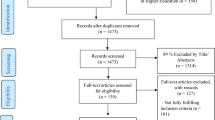Abstract
This paper describes two recent studies by the Science and Engineering Policy Studies Unit (SEPSU). The first is a comparative evaluation of national performance in basic research — an exploration of methodology and extensive data on several facets of national performance. The second deals with the migration of scientists and engineers to and from the UK, and reports a more complex picture than some commentators had expected.
Similar content being viewed by others
References
Work is in hand both on European collaboration and on collaboration between the UK and Japan. A guide to the schemes promoting collaboration between the UK and other European countries has just been published:European collaboration in science and technology: a guide for the UK scientist and engineer (SEPSU, 1987).
THE ROYAL SOCIETY,Evaluation of national performance in basic research (ABRC Science Policy Study No. 1; Advisory Board for the Research Councils, London, 1986); D. C. SMITH, P. M. D. COLLINS, D. M. HICKS, S. WYATT, National performance in basic research,Nature, 323 (1986) 681; P. M. D. COLLINS, M. HART, D. M. HICKS, UK performance in basic solid state physics,Physics in Technology, 18 (1987) 72.
B. R. MARTIN, J. IRVINE,An international comparison of Government funding of academic and academically related research (ABRC Science Policy Study No. 2; Advisory Board for the Research Councils, London 1986).
P. HEALEY, H. ROTHMAN, P. K. HOCH, An experiment in science mapping for research planning,Research Policy, 15 (1986) 233.
Published papers are, of course, not the only product of basic research, and a comprehensive evaluation of performance would also have to look at the skills generated or taught during research, increases in trained manpower, stimulus to colleagues, etc.
These figures are based on average shares for the whole period 1977–84. It would be possible to repeat the calculation year by year; it would also be possible to examine the consequences of setting the threshold at a higher or lower value than 25%.
Our data on citations per paper are only approximate, because the theScience Citation Index records all papers cited in the journals that it scans irrespective of whether the cited papers are published in those journals, whereas the counts of published papers are necessarily restricted toSCI journals. The degree of approximation thus depends on the extent to whichSCI journals constitute a closed set, i.e. the degree to which they cite only otherSCI journals.
This is essentially the methodology developed by Martin and Irvine. See B. R. MARTIN, J. IRVINE, Assessing basic research: some partial indicators of scientific progress in radio astronomy,Research Policy, 12 (1983) 61.
For further details see P. M. COLLINS, S. WYATT, Citations in patents to the basic research literature,Research Policy, (forthcoming).
A group within the CNRS has been using our data to examine French performance in basic research.
The strikingly improving performance of Japan shown in bibliometric data reflects partly its increasing total output and partly the fact that a growing proportion of this output is published in English-language journals. See The Royal Society, ref. 2 above, pp 113–119, for a discussion on the growing extent to which French, German and Japanese scientists publish in English-language journals.
The migration of scientists and engineers to and from the UK (SEPSU Policy Study No. 1; Royal Society/Fellowship of Engineering, London, 1987): P. M. D. COLLINS, G. K. RADDA, J. H. SILVERLEAF, D. C. SMITH, Flows of researchers to and from the UK,Nature, 328 (1987) 27.
Times Higher Education Supplement, 22 May 1987, p. 1.
See, for example,The Times, 1 July 1987, p. 15.
A variety of early interpretations may be found in:The Independent, 30 June 1987, p. 5;Financial Times, 30 June 1987, p. 21; Committe of Vice-Chancellors and Principals, CVCP Chairman endorses Brain Drain report (CVCP press release, 30 June 1987); House of Lords,Hansard, 1 July 1987, cols 250–253.
Author information
Authors and Affiliations
Rights and permissions
About this article
Cite this article
Collins, P.M.D. Research performance and migration: Two SEPSU studies. Scientometrics 14, 201–211 (1988). https://doi.org/10.1007/BF02020075
Received:
Issue Date:
DOI: https://doi.org/10.1007/BF02020075




